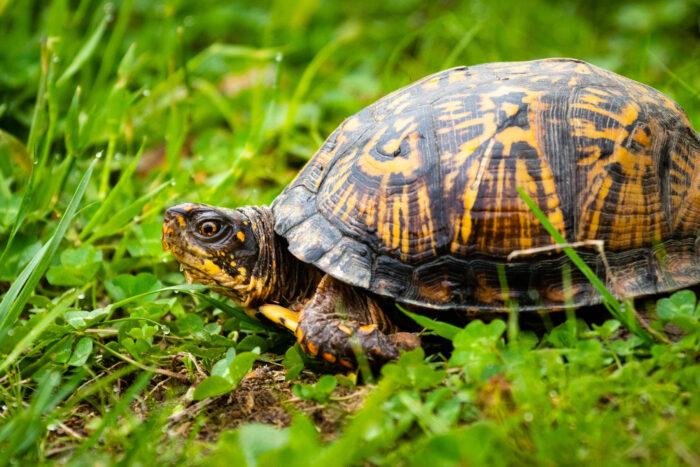Eastern Box Turtle
Terrapene carolina carolina
The eastern box turtle is a terrestrial reptile found primarily in woodlands across the Chesapeake watershed.
This section shows one large critter image at a time. Use the thumbnails that follow to select a specific image to display here.

This gallery contains a grid of small thumbnails. Selecting a thumbnail will change the main image in the preceding section.
Appearance
The eastern box turtle is a small reptile, reaching only about six inches in length and weighing less than one pound. Its tall upper shell, or carapace, is said to resemble a box. The carapace is brown with patterns of orange and yellow markings. Its hinged lower shell, or plastron, allows the turtle to hide its entire body, completely protected by the shell. The plastron is usually dark brown.
The turtle has dark, scaly skin with yellow markings. Eastern box turtles have hooked upper jaws, and their toes are only slightly webbed. Males have red eyes, while females have yellow-brown eyes. Males are also larger than females.
Feeding
Juvenile eastern box turtles feed mostly on animal material, such as slugs, worms, insects and larvae. As adults, they eat mainly plant material, such as seeds, fruits, roots, fungi and grasses. Adults are also known to feed on carrion (flesh of dead animals), fish, amphibians and eggs.
Predators
Because of their ability to retreat into their shell, adult box turtles have few predators. Raccoons, chipmunks, skunks, coyotes, foxes, snakes and owls prey on young box turtles or box turtle eggs.
Reproduction and life cycle
Mating occurs between late spring and early fall. Females dig a nest in loamy or sandy soil to lay their eggs, then cover them with soil and leaf litter. Females lay one or more clutches of 4 to 5 eggs each over late spring and summer.
After 70 to 80 days, eggs hatch, and hatchlings may spend winter in the nest or they may emerge and find another place to hibernate with adults. Turtles will hibernate in depressions, filled with leaf litter or woody debris. Eastern box turtles usually live 40 years, but can live over 100 years.
Did you know?
- The temperature of a turtle’s nest determines the sex of hatchlings; females usually develop at temperatures above 82 degrees Fahrenheit, while males develop between 72 degrees and 81 degrees.
- Box turtles can safely eat poisonous mushrooms, making their own flesh poisonous if consumed by predators.
- Because of its popularity as a pet, this turtle can be found far outside its natural geographic range.
Sources and additional information
- Animal Diversity Web: Terrapene carolina – University of Michigan Museum of Zoology
- Box Turtle – Smithsonian National Zoological Park
- Terrapene carolina – Encyclopedia of Life
